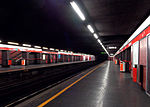Allianz Tower

Allianz Tower (Italian: Torre Allianz), also known as Isozaki Tower (Italian: Torre Isozaki), is a fifty-floor, 209-metre-tall (686 ft) skyscraper in Milan, Italy. Designed by Japanese architect Arata Isozaki and Italian architect Andrea Maffei, it serves as the headquarters of the Allianz Group and the Italian parent company Allianz SpA.Locally nicknamed Il Dritto (Italian for "The Straight One"), it is the tallest building in Italy at 209 m (686 ft)—249 m (817 ft) with broadcast antenna—and with its 50 floors is the tallest to the roof. It is composed by eight modules by six floors each one, with the façade of the module composed by a triple-glass unit slightly curved to outside. The vertical succession of rounded forms create a feeling of slight vibration of the volume of the building as it rises upward. Elevations of the short sides are fully glazed and show the mechanical series of six panoramic lifts going up and down to the various floors of the building. In 2016, Allianz Tower was nominated by Emporis as the third-best skyscraper that was completed in 2015.The idea of an endless tower can be compared to previous ambitions of other artists such as Constantin Brâncuși, for example, who in 1937–38 installed one of his endless columns of Târgu Jiu in the park to create repeatable systems indefinitely.
Excerpt from the Wikipedia article Allianz Tower (License: CC BY-SA 3.0, Authors, Images).Allianz Tower
Piazza Alberto Burri, Milan
Geographical coordinates (GPS) Address External links Nearby Places Show on map
Geographical coordinates (GPS)
| Latitude | Longitude |
|---|---|
| N 45.4776 ° | E 9.1573 ° |
Address
Torre Isozaki (Torre Allianz)
Piazza Alberto Burri
20149 Milan
Lombardy, Italy
Open on Google Maps









